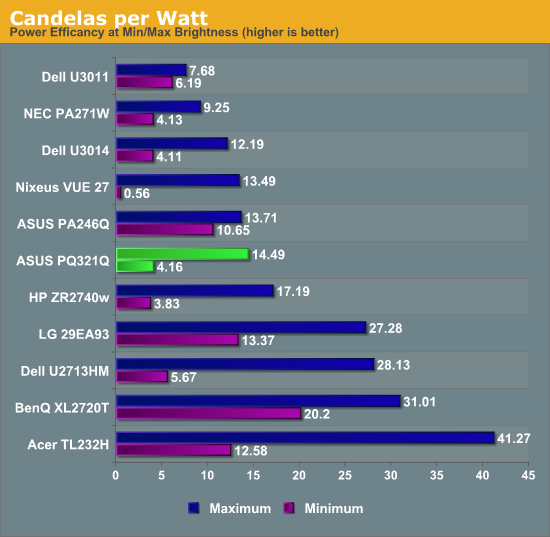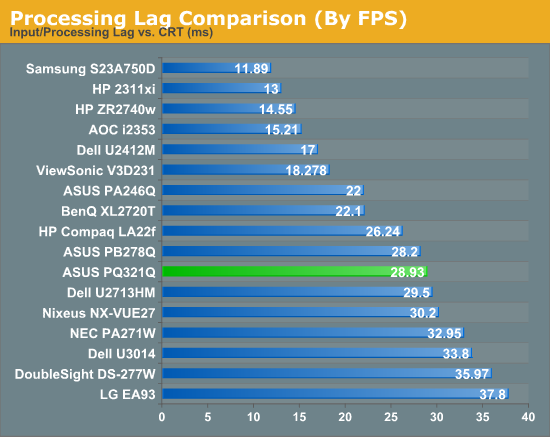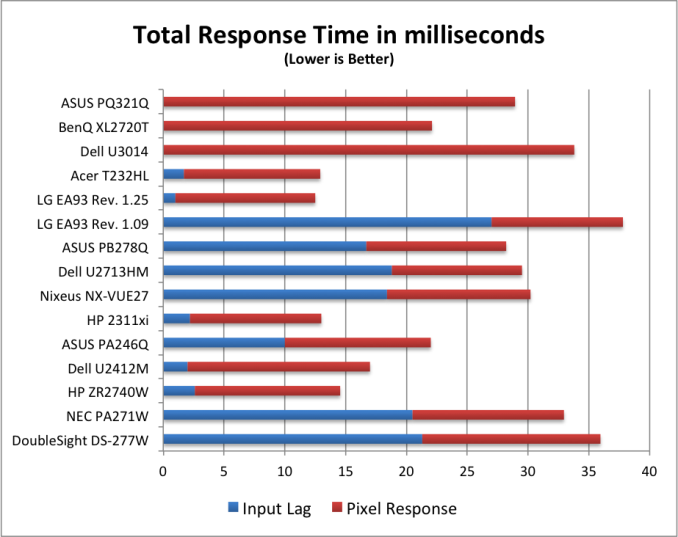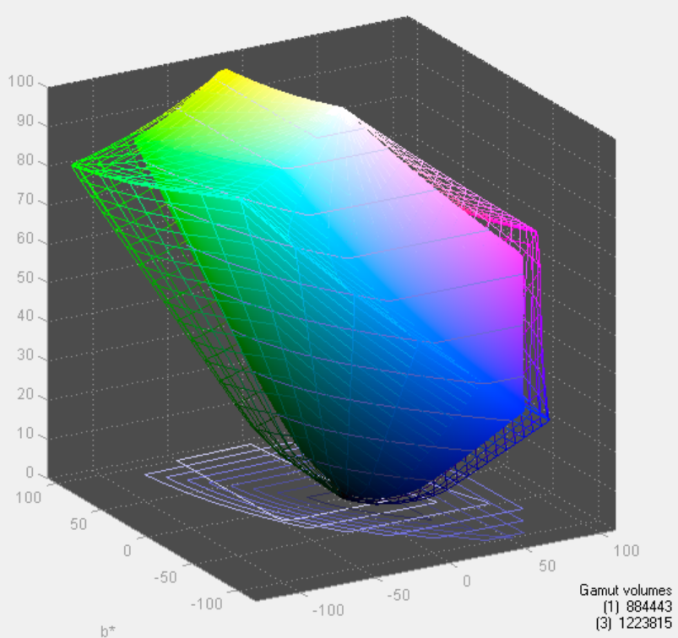ASUS PQ321Q UltraHD Monitor Review: Living with a 31.5-inch 4K Desktop Display
by Chris Heinonen on July 23, 2013 9:01 AM ESTUsing the updated metric for power usage, where I factor in maximum brightness and screen area and not just power usage, the ASUS PQ321Q falls right in the middle of the pack. For both maximum and minimum brightness it does OK but not incredible in comparison to other displays. With the greater transmission of IGZO I would have thought I might see better numbers from the ASUS, but I imagine power usage was very low on the list of concerns relative to other performance numbers.
Overall the ASUS PQ321Q draws a relatively average amount of power compared to other displays.


For testing input lag, I’m again reduced to using the Leo Bodnar lag tester over HDMI. This also means that the ASUS will have to scale the 1080p signal to be 2160p and fill the screen. Unlike before, I think this might be a more accurate test as many people will not be gaming at 2160p yet. Looking at the gaming numbers that our Ian Cutress found with a 4K display, you might want to run at 1080p for a little bit until setting up a 4x Titan rig becomes more affordable. Then again, if you can afford the ASUS PQ321Q, you might be buying a 4x Titan setup as well.
Back to the actual data, and the ASUS comes in at 28.93 ms of lag on average for the 3 measurement locations. This is better than the Dell U3014 monitor does, but slower than the BenQ XL2720T that is a native 1080p display. Given that you have scaling going on here, this actually is a pretty decent result I think.

Despite my GPU only being a GTX 660 Ti, I did try out a little bit of gaming on the ASUS. One question that was debated in Ian’s round-up was the necessity of MSAA at 4K resolutions. Measuring just now, I sit exactly 2’ away from the ASUS PQ321Q, with my eyes around dead center on the display. Turning on Half Life 2 (look, I’m not much of a gamer!), I can easily see the difference between no MSAA, 2x and 4x MSAA. The pixel density would need to be even higher, or I’d need to sit further away, for MSAA to not make a difference.
Without MSAA things still looked very sharp overall, but jagged lines are easy to spot if I look for them. You might be able to more easily get away with 2x or 4x instead of 8x MSAA, but you’ll want to have it enabled. Beyond that, the PQ321Q worked well for my casual gaming. Nothing recognized the display correctly at first, perhaps because of MST, but once in the game you can properly select the 3840x2160 resolution for it.
At the request of a commenter I'm adding some PixPerAn photos, trying to show best and worst case results. I've not used PixPerAn at all before, so feedback would be great. If I've done something wrong with it, I'll try to correct it ASAP.
Looking at the gamut, we see a value that indicates full sRGB gamut coverage. From our earlier images of the CIE diagram we know we don’t have full coverage of red, blue and magenta. It seems the extra green/yellow/orange section is large enough that we get a value that indicates a volume equal to the sRGB space, but some of that volume is an area outside of sRGB. It is close to the sRGB area, but not quite.


















166 Comments
View All Comments
DanNeely - Thursday, July 25, 2013 - link
Probably never since margins are higher on 16:9 screens; a 21" 2560x1440 screen could be made from the same line just by cutting the panels smaller.In that general size bucket though I'd like to see them jump directly to 4k too though for ~200DPI. This is high enough to make AA mostly unneeded when gaming and to allow for 2:1 scaling for legacy apps.
jasonelmore - Wednesday, July 24, 2013 - link
UHD or 4k is gonna be good for the living room simply because TV's will get bigger, and that's where 4k really shines.Back in the day, i remember 32" was massive. Then when HD first came out, 42" was the standard when talking about big screens. Now 55" is the new standard, and 70 inch will probably be common place in the next couple of years. 4k on a 70 inch will look great.
DanNeely - Thursday, July 25, 2013 - link
Maybe. 70/80" TVs require rearranging your living room in ways that smaller sizes don't; and take up enough space that in smaller houses they've often impossible just because you don't have any blank wall sections that big that you can orient furniture around.yhselp - Wednesday, July 24, 2013 - link
PixPerAn FeedbackThe PixPerAn test looks great, you’ve done nothing wrong; on the contrary, the idea is to show the realistic best and worst case scenario out of which the former should be more representative for most users. However, some of your results, namely pictures 2 and 3, seem very optimistic. In my opinion, and from my experience, pictures 4 and 5 show the real best (4) and worst (5) case scenarios. How did you capture the results and under what settings? I could try to replicate the test on my U2311H and compare the results to those that I did when I purchased the monitor and upload the results.
It might be a good idea the crop the relevant pictures (those above), pick out two that are most representative for relevant best and worst case scenarios and create a single picture instead of a gallery. If you decide that more cases should be shown that’s perfectly alright, but an organized single picture would still be easier to read. Also, some context for readers unfamiliar with what this test shows and how to read it would be quite useful.
It’s a common misconception that monitors with higher response time than 2ms are not fast enough. Believe it or not, a lot of people, especially gamers, steer clear of monitors with higher response time. In reality things are much different; the ms rating alone says little. Not all response time ratings are created equal. One might write an article solely about the response time of a monitor, however, without going into technicalities such as RTC, PixPerAn can give an easy to read and understand representation of what a user can actually expect to experience in terms of RT in a monitor. For example, a lighter ghost image or a pale overshoot behind the moving car is usually harder to spot in actual use. PixPerAn is also good for testing stereoscopic 3D ghosting and S3D performance in general; you can clearly see the benefits of NVIDIA LightBoost in the test.
A picture is worth a thousand words, especially in this case. Just by looking at a PixPerAn result you can derive almost everything you need to know about how fast a monitor should actually feel like (and what kind of visual artifacts you might experience). I would be really glad if you make this test standard on all your future monitor reviews, at least here on AnandTech. It wouldn’t take much space in the reviews and should be relatively quick to take. Please, let me know whether you think it’s a useful test, etc.
Thank you for the great review.
sheh - Wednesday, July 24, 2013 - link
3D graphs of response times for all combinations of start/end pixel lightnesses, which were in Xbitlabs reviews, are also interesting.DesktopMan - Wednesday, July 24, 2013 - link
Response time: 8ms GTGEveryone who writes about Igzo (including Chris in this article) talks about how Igzo allows for higher electron mobility which makes a faster display. Then why is the GTG this bad?
Does it do 1080p@120hz? Might not matter if it really is this slow though.
ChristianLG - Wednesday, July 24, 2013 - link
Hello. ¿Why the monitor you are reviewing isn’t a true 4k monitor? ¿ What is a true 4k monitor? Thanks.cheinonen - Friday, July 26, 2013 - link
True 4K, when it comes to digital cinema, is 4096 pixels wide, but the height can vary depending on the content. Since this is only 3840 pixels wide, it falls under the UHD heading, but everyone uses 4K anyway because it sounds good.joshu zh - Wednesday, July 24, 2013 - link
You can find 4K TV in stores now. I can see clearly the difference between 1080P and 4K. You should try it and you may change you thoughts about 4K TV. To me, the issue is you could not find enough 4K materials to watch now. I hope this situation will change in 2-3 years.Sabresiberian - Wednesday, July 24, 2013 - link
One of my "pet peeves" is the fact that the display industry goes out of its way to blur the monitor/TV line. They aren't the same, and selling them as though they were is disingenuous at best. It has given us a 16:9 standard where it doesn't belong - and now we are crashing up against the limits of standards essentially made with low-res and TV in mind.Putting speakers in a $3500 display is like putting a $5 tuner in a Marantz amplifier. Certainly if I have the money to pay for one of these things I'm not going to put up with crap for speakers! It is just about as useless a thing as can be done.
I think the best thing I can say about this monitor is that finally someone has broken the ice, and I give Asus a lot of credit for that. Not saying it's bad, just saying for $3500 I'd like to have seen more polish (better OSD) and better calibrated performance. Nice job Asus, but you could have done better.